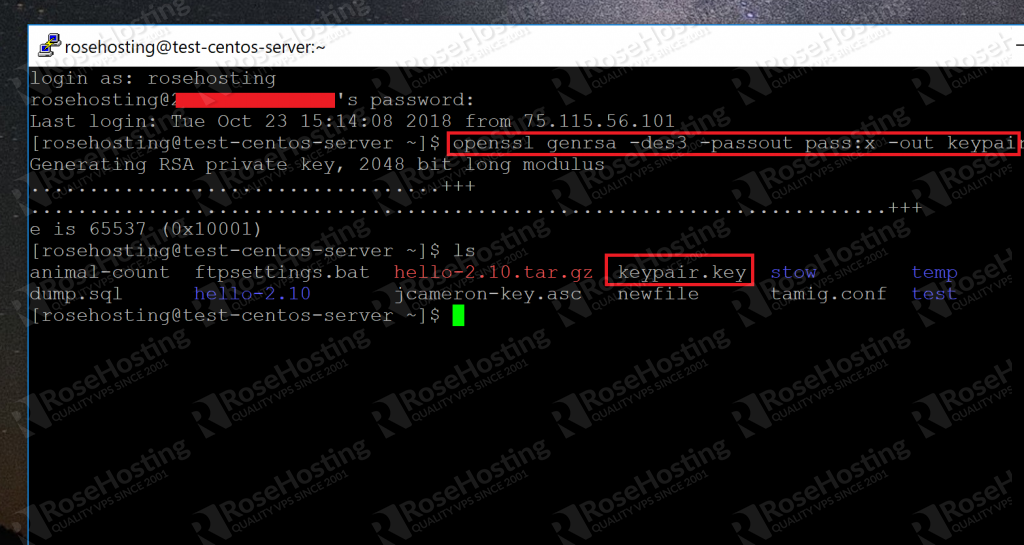Generate Pkcs12 From Crt And Key Openssl
While Encrypting a File with a Password from the Command Line using OpenSSLis very useful in its own right, the real power of the OpenSSL library is itsability to support the use of public key cryptograph for encrypting orvalidating data in an unattended manner (where the password is not required toencrypt) is done with public keys.
The Commands to Run
Generate a 2048 bit RSA Key
- The commands below demonstrate examples of how to create a.pfx/.p12 file in the command line using OpenSSL: PEM (.pem,.crt,.cer) to PFX openssl pkcs12 -export -out certificate.pfx -inkey privateKey.key -in certificate.crt -certfile more.crt.
- Howto convert a PFX to a seperate.key/.crt file. Openssl pkcs12 -in yourfile.pfx -clcerts -nokeys -out certificate.crt Just press enter and your certificate appears. Now as I mentioned in the intro of this article you sometimes need to have an unencrypted.key file to import on some devices.
You can generate a public and private RSA key pair like this:
openssl genrsa -des3 -out private.pem 2048
That generates a 2048-bit RSA key pair, encrypts them with a password you provideand writes them to a file. You need to next extract the public key file. You willuse this, for instance, on your web server to encrypt content so that it canonly be read with the private key.
Jun 19, 2010 Generate a.jks keystore using.key and.crt files: Notes. Tools like in F5 load balancers generate.crt and.key files ( they basically use openssl ). Here.crt is the signed certificate from a CA and key contains the private key. These keys and certificates are in PEM format.
Export the RSA Public Key to a File
This is a command that is
openssl rsa -in private.pem -outform PEM -pubout -out public.pem
The -pubout flag is really important. Be sure to include it.
Next open the public.pem and ensure that it starts with-----BEGIN PUBLIC KEY-----. This is how you know that this file is thepublic key of the pair and not a private key.
To check the file from the command line you can use the less command, like this:
less public.pem
Do Not Run This, it Exports the Private Key
A previous version of the post gave this example in error.
openssl rsa -in private.pem -out private_unencrypted.pem -outform PEM
The error is that the -pubout was dropped from the end of the command.That changes the meaning of the command from that of exporting the public keyto exporting the private key outside of its encrypted wrapper. Inspecting theoutput file, in this case private_unencrypted.pem clearly shows that the keyis a RSA private key as it starts with -----BEGIN RSA PRIVATE KEY-----.
Visually Inspect Your Key Files
It is important to visually inspect you private and public key files to makesure that they are what you expect. OpenSSL will clearly explain the nature ofthe key block with a -----BEGIN RSA PRIVATE KEY----- or -----BEGIN PUBLIC KEY-----.

You can use less to inspect each of your two files in turn:
less private.pemto verify that it starts with a-----BEGIN RSA PRIVATE KEY-----less public.pemto verify that it starts with a-----BEGIN PUBLIC KEY-----
The next section shows a full example of what each key file should look like.
The Generated Key Files
The generated files are base64-encoded encryption keys in plain text format.If you select a password for your private key, its file will be encrypted withyour password. Be sure to remember this password or the key pair becomes useless.
The private.pem file looks something like this:
The public key, public.pem, file looks like:
Protecting Your Keys
Depending on the nature of the information you will protect, it’s important tokeep the private key backed up and secret. The public key can be distributedanywhere or embedded in your web application scripts, such as in your PHP,Ruby, or other scripts. Again, backup your keys!
Remember, if the key goes away the data encrypted to it is gone. Keeping aprinted copy of the key material in a sealed envelope in a bank safety depositbox is a good way to protect important keys against loss due to fire or harddrive failure.
Oh, and one last thing.
If you, dear reader, were planning any funny business with the private key that I have just published here. Know that they were made especially for this series of blog posts. I do not use them for anything else.
Found an issue?
Rietta plans, develops, and maintains applications.
Learn more about our services or drop us your email and we'll e-mail you back.
Other Blog Articles Published by Rietta.com
January 24th, 2009Create Pkcs12 From Crt And Key
Sometimes there are cases when you have a separate private key/certificate pair (perhaps with an intermediate or two) that need to be combined into a single file. This merge can be performed on the command line using OpenSSL.
This is the most basic use case and assumes that we have no intermediates, the private key has no password associated, my.cer is a PEM encoded file, and that we wish to supply a password interactively to protect the output file. Great, but what if that’s not true?
Common Optional Flags
-passin If your private key has a password, you can supply it via this flag (Example: -passin pass:mypass). Note: This flag is not necessary as OpenSSL will ask you for the password interactively if it detects that the private key is passworded, but can be useful for automation.
Openssl Pkcs12 Example
-in You can add extra certificates via additional -in parameters. (Example: -in anothercert.cer)
-inform If your certificates are DER (binary) encoded rather than PEM (base64) use this flag (Example: -inform DER)
-password You can use this flag to specify the output file’s password in a non-interactive fashion (Example: -password pass:mypass). Note: Again, this is useful primarily to reduce interactivity and increase automation/scripting capability.
Openssl Create Pkcs12 From Crt And Key
Much more advanced behavior is available, but if you need that it’s probably time to check the man page.